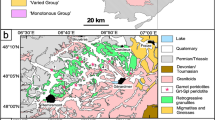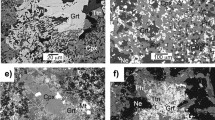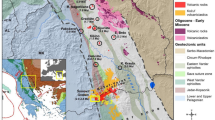Abstract
Corona textures, characterized by specific mineral assemblages as layers between existing phases, are frequently observed in high-grade metamorphic rocks. The mechanisms of corona formation have been extensively investigated, however direct dating of corona phases has rarely to be attempted. In order to decipher the timing and duration of corona formation and its implications for metamorphic processes, an integrated garnet Lu–Hf and Sm–Nd and zircon U–Pb petrochronological study was conducted on a corona-bearing granulite from the Miyun region in the North China Craton. The Miyun region, located at the joint area of the Archean Eastern Block and the Paleoproterozoic Trans-North China Orogen, offers a distinctive opportunity to study polymetamorphic processes within the North China Craton. The sample shows a corona texture, primarily composed of garnet, minor clinopyroxene and quartz, that formed at the boundary between plagioclase and orthopyroxene. Pseudosection modelling for the effective bulk composition of reactive domains and conventional thermobarometric calculations indicate that the anhydrous corona assemblage (comprising clinopyroxene, garnet and quartz) formed at ~ 0.9 GPa and ~ 740 ℃. The subsequent hydrous retrogression took place at ~ 0.5 GPa and ~ 670 ℃ and led to the growth of amphibole and biotite. A Lu–Hf garnet date of 1864 ± 3 Ma is significantly younger than the U–Pb date of ca. 2454 Ma for metamorphic zircons in the sample, consistent with the disequilibrium partitioning of rare earth elements between the two phases. The well-preserved Lu zoning in garnet supports the interpretation that the Lu–Hf date represents the age of garnet growth and approximates the timing of formation of the anhydrous corona assemblage. Thus, the U–Pb age reflects a distinct Archean metamorphic event that has been widely documented in high-grade rocks across the Eastern Block of the North China Craton. The garnet Sm–Nd date of 1817 ± 6 Ma is indistinguishable from an amphibole-biotite Lu–Hf date of 1819 ± 16 Ma and ~ 47 Myr younger than the corresponding garnet Lu–Hf date. The younger Sm–Nd age represents the timing of cooling and post-dates retrogression. The Paleoproterozoic and Archean ages in the Miyun granulite align with the major tectonic events in the Trans-North China Orogen and the Eastern Block, respectively. This consistency suggests that the Miyun region likely experienced concurrent metamorphic events in both the Trans-North China Orogen and the Eastern Block. This texture-based Lu–Hf and Sm–Nd dating approach has wide applicability for rocks with explicit textures, facilitating precise extraction of temporal intervals in the metamorphic process.











Similar content being viewed by others
Data availability
Data available within the article or its supplementary materials.
References
Anderson JL, Smith DR (1995) The effects of temperature and fo, on the Al-in-hornblende barometer. Am Mineral 80:549–559. https://doi.org/10.2138/am-1995-5-614
Aranovich LY, Berman RG (1997) A new garnet-orthopyroxene thermometer based on reversed Al2O3 solubility in FeO–Al2O3–SiO2 orthopyroxene. Am Mineral 82(3–4):345–353. https://doi.org/10.2138/am-1997-3-413
Ashworth JR, Sheplev VS (1997) Diffusion modeling of metamorphic layered coronas with stability criterion and consideration of affinity. Geochim Cosmochim Acta 61(17):3671–3689. https://doi.org/10.1016/S0016-7037(97)00190-7
Baxter EF, Scherer EE (2013) Garnet Geochronology: Timekeeper of Tectonometamorphic Processes. Elements 9:433–438. https://doi.org/10.2113/gselements.9.6.433
Blichert-Toft J, Chauvel C, Albarède F (1997) Separation of Hf and Lu for high-precision isotope analysis of rock samples by magnetic sector-multiple collector ICP-MS. Contrib Mineral Petrol 127:248–260. https://doi.org/10.1007/s004100050278
Bröcker M, Enders M (1999) U–Pb zircon geochronology of unusual eclogite-facies rocks from Syros and Tinos (Cyclades, Greece). Geol Mag 136:111–118. https://doi.org/10.1017/S0016756899002320
Brown M (2001) From microscope to mountain belt: 150 years of petrology andits contribution to understanding geodynamics, particularly the tectonics oforogens. J Geodyn 32:115–164. https://doi.org/10.1016/S0264-3707(01)00018-7
Chakraborty S, Ganguly J (1992) Cation diffusion in aluminosilicate garnets: experimental determination in spessartine-almandine diffusion couples, evaluation of effective binary diffusion coefficients, and applications. Contrib Mineral Petrol 111:74–86. https://doi.org/10.1007/BF00296579
Cheng H, King RL, Nakamura E, Vervoort JD, Zhou Z (2008) Coupled Lu-Hf and Sm-Nd geochronology constrains garnet growth in ultra-high-pressure eclogites from the Dabie orogen. J Metamorph Geol 26(7):741–758. https://doi.org/10.1111/j.1525-1314.2008.00785.x
Cheng H, King RL, Nakamura E, Vervoort JD, Zheng YF, Ota T, Wu YB, Kobayashi K, Zhou ZY (2009) Transitional time of oceanic to continental subduction in the Dabie orogen: Constraints from U-Pb, Lu-Hf. Sm-Nd and Ar-Ar Multichronometric Dating Lithos 110(1–4):327–342. https://doi.org/10.1016/j.lithos.2009.01.013
Cheng H, Vervoort JD, Dragovic B, Wilford D, Zhang LM (2018) Coupled Lu–Hf and Sm–Nd geochronology on a single eclogitic garnet from the Huwan shear zone, China. Chem Geol 476:208–222. https://doi.org/10.1016/j.chemgeo.2017.11.018
Cheng H, Bloch EM, Moulas E, Vervoort JD (2020) Reconciliation of discrepant U-Pb, Lu–Hf, Sm–Nd, Ar–Ar and U–Th/He dates in an amphibolite from the Cathaysia Block in Southern China. Contrib Mineral Petrol 175:4. https://doi.org/10.1007/s00410-019-1644-9
Cherniak DJ (2003) REE diffusion in feldspar. Chem Geol 193(1–2):25–41. https://doi.org/10.1016/S0009-2541(02)00246-2
Cherniak DJ, Liang Y (2007) Rare earth element diffusion in natural enstatite. Geochim Cosmochim Acta 71:1324–1340. https://doi.org/10.1016/j.gca.2006.12.001
Connolly JAD (1990) Multivariable phase-diagrams—an algorithm based on generalized thermodynamics. Am J Sci 290:666–718. https://doi.org/10.2475/ajs.290.6.666
Corfu F, Hanchar JM, Hoskin PWO, Kinny P (2003) Atlas of Zircon Textures. Rev in Mineral Geochem 53(1):469–500. https://doi.org/10.2113/0530469
Deer WA, Howie RA, Zussman J (1992) The Rock-forming minerals, 2nd edn. Pearson, London
Dragovic B, Baxter EF, Caddick MJ (2015) Pulsed dehydration and garnet growth during subduction revealed by zoned garnet geochronology and thermodynamic modeling, Sifnos, Greece. Earth Planet Sci Lett 413:111–122. https://doi.org/10.1016/j.epsl.2014.12.024
Eckert JO, Newton RC, Kleppa OJ (1991) The ΔH of reaction and recalibration of garnetpyroxene-plagioclase-quartz geobarometers in the CMAS system by solution calorimetry. Am Mineral 76:148–160
Ellis DJ, Green DH (1979) An experimental study of the effect of Ca upon garnet-clinopyroxene Fe-Mg exchange equilibria. Contrib Mineral Petrol 71(1):13–22. https://doi.org/10.1007/BF00371878
Fang TM, Cheng XB, Sun YH, Liu H, Wu HJ, Wei B, Wang W, Ding W (2017) Geochemical characteristics and metallogenic age of BIF type Fe deposit at Shachang in Miyun County. Bei**g. Contrib Geol Mineral Res Res 32: 042–049. in Chinese with English abstract.
Ganguly J, Tirone M, Hervig R (1998) Diffusion kinetics of samarium and neodymium in garnet, and a method for determining cooling rates of rocks. Science 281:805–807. https://doi.org/10.1126/science.281.5378.805
Gerya TV, Stöckhert B, Perchuk AL (2002) Exhumation of high-pressure metamorphic rocks in a subduction channel: A numerical simulation. Tectonics 21(6): 6–1–6–19. https://doi.org/10.1029/2002TC001406
Ghosh S, Prabhaka N, D’Souza J (2021) Origin of multilayer corona textures in mafic granulites from the Sandmata Complex, Aravalli Craton (northwestern India): petrological characteristics and tectonic implications. Contrib Mineral Petrol 176(5):35. https://doi.org/10.1007/s00410-021-01782-9
Goncalves P, Nicollet C, Lardeaux JM (2003) Finite strain pattern in Andriamena unit (north-central Madagascar): evidence for late Neoproterozoic-Cambrian thrusting during continental convergence. Precambrian Res 123(2–4):135–157. https://doi.org/10.1016/S0301-9268(03)00065-2
Green ECR, White RW, Diener JFA, Powell R, Holland TJB, Palin RM (2016) Activity–composition relations for the calculation of partial melting equilibria in metabasic rocks. J Metamor Geol 34(9):845–869. https://doi.org/10.1111/jmg.12211
Guevara VE, Caddick MJ, Dragovic B (2017) Rapid high-T decompression recorded by Archean granulites in the northern Wyoming Province: Insights from petrological modelling. J Metamorph Geol 35:943–965. https://doi.org/10.1111/jmg.12262
Harley S (1989) The origins of granulites: A metamorphic perspective. Geol Mag 126(3):215–247. https://doi.org/10.1017/S0016756800022330
Harley SL, Kelly NM, Moller A (2007) Zircon Behaviour and the Thermal Histories of Mountain Chains. Elements 3(1):25–30. https://doi.org/10.2113/gselements.3.1.25
Holland TJB, Powell R (2011) An improved and extended internally consistent thermodynamic dataset for phases of petrological interest, involving a new equation of state for solids. J Metamor Geol 29(3):333–383. https://doi.org/10.1111/j.1525-1314.2010.00923.x
Hoskin PWO, Black LP (2000) Metamorphic zircon formation by solid-state recrystallization of protolith igneous zircon. J Metamor Geol 18:423–439. https://doi.org/10.1046/j.1525-1314.2000.00266.x
Jackson SE, Pearson NJ, Griffin WL, Belousova EA (2004) The application of laser ablation-inductively coupled plasma-mass spectrometry to in situ U-Pb zircon geochronology. Chem Geol 211(1–2):47–69. https://doi.org/10.1016/j.chemgeo.2004.06.017
Jian P, Kröner A, Windley BF, Zhang W, Zhang LQ (2012) Episodic mantle melting-crustal reworking in the late Neoarchean of the northwestern North China Craton: Zircon ages of magmatic and metamorphic rocks from the Yinshan Block. Precambrian Res 222:230–254. https://doi.org/10.1016/j.precamres.2012.03.002
Jochum KP, Willbold M, Raczek I, Stoll B, Herwig K (2005) Chemical characterization of the USGS reference glasses GSA-1G, GSC-1G, GSD-1G, GSE-1G, BCR-2G, BHVO-2G and BIR-1G using EPMA, ID-TIMS, ID-ICP-MS and LA-ICP-MS. Geostand Geoanal Res 29:285–302. https://doi.org/10.1111/j.1751-908X.2005.tb00901.x
Kelly ED, Carlson WD, Connelly JN (2011) Implications of garnet resorption for the Lu–Hf garnet geochronometer: An example from the contact aureole of the Makhavinekh Lake Pluton, Labrador. J Metamorph Geol 29:901–916. https://doi.org/10.1111/j.1525-1314.2011.00946.x
Kusiak MA, Whitehouse MJ, Wilde SA, Nemchin AA, Clark C (2013) Mobilization of radiogenic Pb in zircon revealed by ion imaging: Implications for early Earth geochronology. Geology 41(3):291–294. https://doi.org/10.1130/G33920.1
Kusky TM, Polat A, Windley BF, Burke KC, Dewey JF, Kidd WSF, Maruyama S, Wang JP, Deng H, Wang ZS, Wang C, Fu D, Li XW, Peng HT (2016) Insights into the tectonic evolution of the North China Craton through comparative tectonic analysis: A record of outward growth of Precambrian continents. Earth Sci Rev 162:387–432. https://doi.org/10.1016/j.earscirev.2016.09.002
Leake BE, Woolley AR, Arps CES, Birch WD, Gilbert CM, Grice JD et al (1997) Nomenclatureof amphiboles; report of the subcommittee on amphiboles of the InternationalMineralogical Association, Commission on New Minerals and Mineral Names. Mineral Mag 61(405):295–310. https://doi.org/10.1180/minmag.1997.061.405.13
Li XM, Cheng H, Dragovic B, Du KY, Zhou Y (2022) Multi-mineral petrochronology on a high-pressure mafic granulite reveals short-lived high-temperature metamorphism in the North China Craton. J Metamorph Geol 40:1447–1466. https://doi.org/10.1111/jmg.12681
Liu DY, Nutman AP, Compston W, Wu JS, Shen QH (1992) Remnants of ≥3800 Ma crust in the Chinese part of the Sino-Korean craton. Geology 20:339–342. https://doi.org/10.1130/0091-761
Lugmair GW, Marti K (1978) Lunar initial 143Nd/144Nd: Differential evolution of the lunar crust and mantle. Earth Planet Sci Lett 39(3):349–357. https://doi.org/10.1016/0012-821X(78)90021-3
Mezger K, Essene EJ, Halliday AN (1992) Closure temperature of the Sm–Nd system in metamorphic garnets. Earth Planet Sci Lett 113:397–409. https://doi.org/10.1016/0012-821X(92)90141-H
Morimoto N (1988) Nomenclature of Pyroxenes Mineral Petrol 39:55–76. https://doi.org/10.1007/BF01226262
Nakamura D (2009) A new formulation of garnet–clinopyroxene geothermometer based on accumulation and statistical analysis of a large experimental data set. J Metamorph Geol 27(7):495–508. https://doi.org/10.1111/j.1525-1314.2009.00828.x
Newton RC, Perkins D (1982) Thermodynamic calibration of geobarometers based on the assemblages garnet-plagioclase-orthopyroxene (clinopyroxene)-quartz. Am Mineral 67:203–222
Ogilvie P, Gibson RL (2017) Arrested development – a comparative analysis of multilayer corona textures in high-grade metamorphic rocks. Solid Earth 8(1):93–135. https://doi.org/10.5194/se-8-93-2017
Otamendi JE, de la Rosa JD, Patino Douce AE, Castro A (2002) Rayleigh fractionation of heavy rare earths and yttrium during metamorphic garnet growth. Geology 30(2):159–162. https://doi.org/10.1130/0091-7613(2002)030%3c0159:RFOHRE%3e2.0.CO;2
Pearce NJG, Perkins WT, Westgate JA, Gorton MP, Jackson SE, Neal CR, Chenery SP (1997) A compilation of new and published major and trace element data for NIST SRM 610 and NIST SRM 612 glass reference materials. Geostand newsl 21, 115–144: https://doi.org/10.1111/j.1751-908X.1997.tb00538.x
Pehrsson SJ, Berman RG, Eglington B, Rainbird R (2013) Two Neoarchean supercontinents revisited: The case for a Rae family of cratons. Precambrian Res 232:27–43. https://doi.org/10.1016/j.precamres.2013.02.005
Perchuk LL, Aranovich LY, Podlesskii KK, Lavranteva IV, Gerasimov VY, FedKin VV, Berdnikov NV (1985) Precambrian granulites of the Aldan shield, eastern Siberia, USSR. J Metamorp Geol 3(3):265–310. https://doi.org/10.1111/j.1525-1314.1985.tb00321.x
Pidgeon RT, Nemchin AA, Hitchen GJ (1998) Internal structures of zircons from Archean granites from the Darling Range batholith: Implications for zircon stability and the interpretation of zircon U-Pb ages. Contrib Mineral Petrol 132:288–299. https://doi.org/10.1007/s004100050422
Powell R (1985) Geothermometry and geobarometry: a discussion. J Geol Soc London 142:29–38. https://doi.org/10.1144/gsjgs.142.1.0029
Rubatto D (2002) Zircon trace element geochemistry: Partitioning with garnet and the link between U-Pb ages and metamorphism. Chem Geol 184(1–2):123–138. https://doi.org/10.1016/S0009-2541(01)00355-2
Rubatto D (2017) Zircon: The Metamorphic Mineral. Rev in Mineral Geochem 83:261–295. https://doi.org/10.2138/rmg.2017.83.9
Schaltegger U, Fanning CM, Gunther D, Maurin JC, Schulmann K, Gebauer D (1999) Growth, annealing and recrystallization of zircon and preservation of monazite in high-grade metamorphism: Conventional and in situ U-Pb isotope, cathodoluminescence and microchemical evidence. Contrib Mineral Petrol 134:186–201. https://doi.org/10.1007/s004100050478
Scherer E, Münker C, Mezger K (2001) Calibration of the lutetium-hafnium clock. Science 293:3–7. https://doi.org/10.1126/science.1061372
Shi Y, Wilde SA, Zhao X, Ma Y, Du L, Liu D (2012) Late Neoarchean magmatic and subsequent metamorphic events in the northern North China Craton: SHRIMP zircon dating and Hf isotopes of Archean rocks from Yunmengshan Geopark, Miyun. Bei**g Gondwana Res 21(4):785–800. https://doi.org/10.1016/j.gr.2011.07.009
Sláma J, Košler J, Condon DJ et al (2008) Plešovice zircon—A new natural reference material for U-Pb and Hf isotopic microanalysis. Chem Geol 249:1–35. https://doi.org/10.1016/j.chemgeo.2007.11.005
Smit MA, Scherer EE, Bröocker M, van Roermund HL (2010) Timing of eclogite facies metamorphism in the southernmost Scandinavian Caledonides by Lu–Hf and Sm–Nd geochronology. Contrib Mineral Petrol 159:521–539. https://doi.org/10.1007/s00410-009-0440-3
Smit MA, Scherer EE, Mezger K (2013) Lu–Hf and Sm–Nd garnet geochronology: Chronometric closure and implications for dating petrological processes. Earth Planet Sci Lett 381:222–233. https://doi.org/10.1016/j.epsl.2013.08.046
Söderlund U, Patchett PJ, Vervoort JD, Isachsen CE (2004) The 176Lu decay constant determined by Lu-Hf and U-Pb isotope systematics of Precambrian mafic intrusions. Earth Planet Sci Lett 219(3–4):311–324. https://doi.org/10.1016/S0012-821X(04)00012-3
Starr PG, Broadwell KS, Dragovic B, Scambelluri M, Haws AA, Caddick MJ, Smye AJ, Baxter EF (2020) The subduction and exhumation history of the Voltri Ophiolite, Italy: evaluating exhumation mechanisms for high-pressure metamorphic massifs. Lithos 376–377:105767. https://doi.org/10.1016/j.lithos.2020.105767
Tanaka T, Togashi S, Kamioka H, Amakawa H, Kagami H, Hamamoto T, Yuhara M, Orihashi Y, Yoneda S, Shimizu H, Kunimaru T, Takahashi K, Yanagi T, Nakano T, Fujimaki H, Shinjo R, Asahara Y, Tanimizu M, Dragusanu C (2000) JNdi-1: a neodymium isotopic reference in consistency with LaJolla neodymium. Chem Geol 168(3–4):279–281. https://doi.org/10.1016/S0009-2541(00)00198-4
Tang L, Santosh M (2018) Neoarchean granite-greenstone belts and related ore mineralization in the North China Craton: An overview. Geosci Front 9(3):751–768. https://doi.org/10.1016/j.gsf.2017.04.002
Tang L, Santosh M, Tsunogae T (2019) Petrology, phase equilibria modelling and zircon U-Pb geochronology of garnet-bearing charnockites from the Miyun area: Implications for microblock amalgamation of the North China Craton. Lithos 324–325:234–245. https://doi.org/10.1016/j.lithos.2018.11.012
Taylor RJM, Harley SL, Hinton RW, Elphick S, Clark C, Kelly NM (2015) Experimental determination of REE partition coefficients between zircon, garnet and melt: A key to understanding high-T crustal processes. J Metamorph Geol 33(3):231–248. https://doi.org/10.1111/jmg.12118
Taylor RJM, ClarkC HSL, Kylander-Clark ARC, Hacker BR, Kinny PD (2017) Interpreting granulite facies events through rare earth element partitioning arrays. J Metamorph Geol 35:759–775. https://doi.org/10.1111/jmg.12254
Thiessen EJ, Gibson HD, Regis D, Pehrsson SJ, Ashley KT, Smit MA (2020) The distinct metamorphic stages and structural styles of the 1.94–1.86 Ga Snowbird Orogen, Northwest Territories, Canada. J Metamorph Geol 38(9):963–992. https://doi.org/10.1111/jmg.12556
Tirone M, Ganguly J, Dohmen R, Langenhorst F, Hervig R, Becker HW (2005) Rare earth diffusion kinetics in garnet: experimental studies and applications. Geochim Cosmochim Acta 69(9):2385–2398. https://doi.org/10.1016/j.gca.2004.09.025
Tual L, Smit MA, Kooijman E, Kielman-Schmitt M, Ratschbacher L (2022) Garnet, zircon, and monazite age and REE signatures in (ultra)high-temperature and high-pressure rocks: Examples from the Caledonides and the Pamir. J Metamorph Geol 40(8):1321–1346. https://doi.org/10.1111/jmg.12667
Van Orman JA, Grove TL, Shimizu N (2001) Rare earth element diffusion in diopside: influence of temperature, pressure, and ionic radius, and an elastic model for diffusion in silicates. Contrib Mineral Petrol 141(6):687–703. https://doi.org/10.1007/s004100100269
Vavra G, Gebauer D, Schmid R, Compston W (1996) Multiple zircon growth and recrystallization during polyphase Late Carboniferous to Triassic metamorphism in granulites of the Ivrea zone (Southern Alps): An ion microprobe (SHRIMP) study. Contrib Mineral Petrol 122:337–358. https://doi.org/10.1007/s004100050132
White RW, Powell R, Holland TJB, Johnson TE, Green ECR (2014) New mineral activity-composition relations for thermodynamic calculations in metapelitic systems. J Metamorph Geol 32(3):261–286. https://doi.org/10.1111/jmg.12071
Whitney DL, Evans BW (2010) Abbreviations for names of rock-forming minerals. Am Mineral 95:185–187. https://doi.org/10.2138/am.2010.3371
Wiedenbeck M, Allé P, Corfu F, Griffin WL, Meier M, Oberli F, Von Quadt A, Roddick JC, Spiegel W (1995) Three Natural Zircon Standards for U-Th-Pb, Lu-Hf, trace element and ree analyses. Geostand Newsl 19(1):1–23. https://doi.org/10.1111/j.1751-908X.1995.tb00147.x
Wilde SA, Cawood PA, Wang K, Nemchin AL (2005) Granitoid evolution in the late Archean Wutai Complex, North China Craton. J Asian Earth Sci 24:597–613. https://doi.org/10.1016/j.jseaes.2003.11.006
Wu C, Chen HX (2015) Revised Ti-in-biotite geothermometer for ilmenite- or rutile-bearing crustal metapelites. Sci Bull 60:116–121. https://doi.org/10.1007/s11434-014-0674-y
Zhang HCG, Liu JH, Chen YC, Zhang QWL, Tho Pham V, Peng T, Li ZMG, Wu CM (2019) Neoarchean metamorphic evolution and geochronology of the Miyun metamorphic complex, North China Craton. Precambrian Res 320:78–92. https://doi.org/10.1016/j.precamres.2018.10.015
Zhang HCG, Peng T, Liu JH, Wang J, Chen YC, Zhang QWL, Wu CM (2020) New geochronological evidences of late Neoarchean and late Paleoproterozoic tectono-metamorphic events in the Miyun area. North China Craton Precambrian Res 345:105774. https://doi.org/10.1016/j.precamres.2020.105774
Zhang HCG, Liu JH, Wang J, Chen YC, Peng T, Wu CM (2021) Paleoproterozoic metamorphism of metaultramafic rocks in the Miyun area, northeastern North China Craton. Precambrian Res 354:106048. https://doi.org/10.1016/j.precamres.2020.106048
Zhao G, Cawood PA (2012) Precambrian geology of China. Precambrian Res 222–223:13–54. https://doi.org/10.1016/j.precamres.2012.09.017
Zhao G, Sun M, Wilde SA, Li S (2005) Late Archean to Paleoproterozoic evolution of the North China Craton: Key issues revisited. Precambrian Res 136(2):177–202. https://doi.org/10.1016/j.precamres.2004.10.002
Acknowledgements
The authors appreciate Jeffrey D. Vervoort for continuous support and thank Peter L. Baker for help with isotope analyses at Pullman. Lingmin Zhang and Ying Zhou are acknowledged for hel** electron probe and LA–ICP-MS analyses. This work was funded by the National Natural Science Foundation of China (41925013). We thank Matthijs A. Smit and two anonymous reviewers for their thorough reviews which substantially improved this manuscript. The careful editorial handling by Daniela Rubatto, including valuable comments and suggestions, is gratefully acknowledged.
Author information
Authors and Affiliations
Corresponding author
Additional information
Communicated by Daniela Rubatto.
Publisher's Note
Springer Nature remains neutral with regard to jurisdictional claims in published maps and institutional affiliations.
Supplementary Information
Below is the link to the electronic supplementary material.
Rights and permissions
Springer Nature or its licensor (e.g. a society or other partner) holds exclusive rights to this article under a publishing agreement with the author(s) or other rightsholder(s); author self-archiving of the accepted manuscript version of this article is solely governed by the terms of such publishing agreement and applicable law.
About this article
Cite this article
Du, KY., Cheng, H., Dragovic, B. et al. Dating corona formation in high-grade rocks: integrated garnet and zircon petrochronology of granulite-facies rocks in the North China Craton. Contrib Mineral Petrol 178, 94 (2023). https://doi.org/10.1007/s00410-023-02077-x
Received:
Accepted:
Published:
DOI: https://doi.org/10.1007/s00410-023-02077-x




